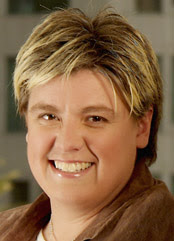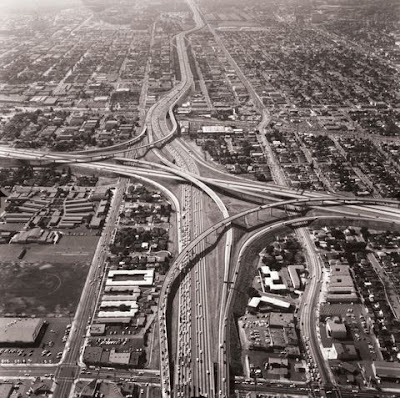Environmental Justice in Transportation: Profile of Lisa Schweitzer
Plenty of UCLA planning related profiles lately, gathered here for the faithful. Today’s is UCLA PhD Lisa Schweitzer, who now teaches and does whatnot at USC somewhere across town. This is reproduced, with permission, from the November 2007 Metrans Transportation Center Newsletter. Lisa was the 2003 University of California Transportation Student of the Year. And oh yeah, if I remember correctly, I was her thesis advisor. Among other critical lessons she’ll never forget, I told her where the Santa Monica Freeway went — all the way to downtown LA — but that probably got cut by the editor.
**************
(Metrans Transportation Center Newsletter, November 2007)

Cities fascinate Lisa Schweitzer, and they always have. She attributes it to her small-town Iowa origins. As a youngster, she was drawn to the mystique of transportation, and how it could lead her to big cities. She tells it this way, “I was picking up litter with the sheriff of the small county where I lived, and we were near Highway 20. I asked him where it went and he told me, and then I asked where did that road go. He said it was Interstate 80 and it went all the way to San Francisco.” Enthralled, she wanted to visit.
Along the route to her present position as a new Assistant Professor in USC’s School of Policy, Planning and Development, Schweitzer took a turn at social work. “I was not good at it, but I was a good grant writer,” she reminisces. “I noticed so many interesting transportation things about my probation clients. If they were poor and depended on public transit, their lives were radically different than if they could drive.” So perhaps it is no wonder this small-town Midwesterner now loves living in downtown Los Angeles and studying environmental issues in transportation.
But she doesn’t drive. “I am a terrible driver,” she explains. How does this non-driver get along in Los Angeles? “I enjoy riding the bus, because it gives me good insight,” laughs Schweitzer. She uses that insight to study metropolitan transportation issues.

Environmental Justice and Urban Transportation
Among her more intriguing research topics is the incidence of hazardous materials spills. “Most spills are generated either onsite or within two kilometers of an intermodal facility,” says Schwietzer. “I did a national study and found that was pretty much true everywhere,” she continues. “A lot of people have a tendency to focus on factories in environmental justice, and these transfer points (intermodal facilities) are really an important land use.”
This issue becomes an environmental justice topic in the context of the demographics of the neighborhoods surrounding typical intermodal facilities in Southern California. “The people on the front lines of this are primarily Latinos,” she notes. “People are starting to pay more attention to them, because of the diesel trucks, train traffic, etc. When we talk about Homeland Security, we’re talking about environmental justice as well.”
Land Use and Transportation
Schweitzer understands the dilemmas of safe residential areas and nearby hazmat transportation routes. “From the shippers’ perspective, they don’t want this either,” she explains. “Good land use planning protects both the residents and the facilities. Good buffer zones are in the interests of everyone.”
Such applied questions of environmental justice fascinate Schweitzer, and she has a soft spot for those who live and work “in the trenches.” “The real work of environmental justice is happening among activists, and they give me really good ideas for research.”
For example, as a doctoral student at UCLA, her dissertation about hazardous materials resulted from conversations with activists. “We had these huge models for hazardous materials determining the routing through cities, minimizing population exposure. The routing software is extremely good. But then I listened to activists talk about how the traffic really irritates them and how it made them feel they were at increased risk because of living near the terminals. That’s a really different empirical question.” She was intrigued.
“Each link of a trip has some hazards associated with it due to traffic, road configuration, etc. It is not the same as saying ‘Our risk is different, being close to the origination or destination.’ I didn’t think anyone had ever studied it. So I did.” Her findings somewhat corroborated the fear felt by neighbors.
“There are reasons why spills happen at those points—a node concentrates the risk.” On the other hand, she notes that “It’s actually a good thing small spills happen where there are professional staff to deal with it. They’re extremely infrequent—people have a much higher risk of being hit by a car—however, evacuations are irritating enough and people really hate them!”
Refinery Risks
In recent research, Schweitzer has tracked the accidents of the major Southern California oil refineries and found significant differences among them. “The likelihood of new incidents is a function of previous incidents,” she notes, probably because safety training, operational practices, and equipment vary. Yet locally they are all found near poor-to-moderate income residential areas, exacerbating the environmental justice issue.
Schweitzer feels safety risk information could be helpful to land use planners. Yet they typically do not have access to such information. Instead the information is used by risk specialists—e.g., the insurance industry. She hopes to add risk assessment to the planner’s tool kit. In the interim, her analysis is challenging reviewers. “The method I used, a Bayesian approach, will over-predict a little, but I’m making an argument that land-use planners should be taking into account all this.”

Teaching Professional Planners
In addition to research, Schweitzer enjoys teaching. At Virginia Polytechnic University, she won the Award for Teaching Excellence in the College of Architecture. “I get a kick out of being able to talk about topics I am passionate about—and I love teaching planners! I love my job, and I love watching my students become professionals,” she said with a smile in her voice.
At USC, Schweitzer enjoys the variety of applied backgrounds her students bring to the classroom. She currently has a student who served in the Peace Corps in Honduras and another who has worked for the Federal Energy Regulatory Commission. With such connections, Schweitzer’s findings about transportation and environmental justice are likely to have a very wide impact indeed.
- Published:
- Friday, January 11th, 2008
- Author:
- randall Crane
- Topics:
- environment, land use, Students
Blogroll
- Becker-Posner blog
- BLDG BLOG
- Burb
- CityStates
- Curbed LA
- Cyburbia
- DemocraticSPACE
- Environmental and Urban Economics
- Freakonomics
- LA Transportation Headlines
- Peter Gordon’s Blog
- Planetizen
- The Center for Land Use Interpretation
- The Transportationist
- the urban commons
- This week’s finds in planning
- Urbanicity
Journals
- Cityscape
- environment and planning a,b,c,d
- Harvard Design Magazine
- Housing Policy Debate
- Housing Studies
- International Development Planning Review
- International Journal of Urban and Regional Research
- International Regional Science Review
- Journal of Architectural and Planning Research
- Journal of Housing Economics
- Journal of Planning Education and Research
- Journal of Planning Literature
- Journal of Regional Science
- Journal of the American Planning Association
- Journal of Urban Affairs
- Journal of Urban Economics
- Planning Theory
- Regional Science & Urban Economics
- Transportation Research Parts A,B,C,D,E,F
- Urban Studies
- World Development


Comments are closed
Comments are currently closed on this entry.